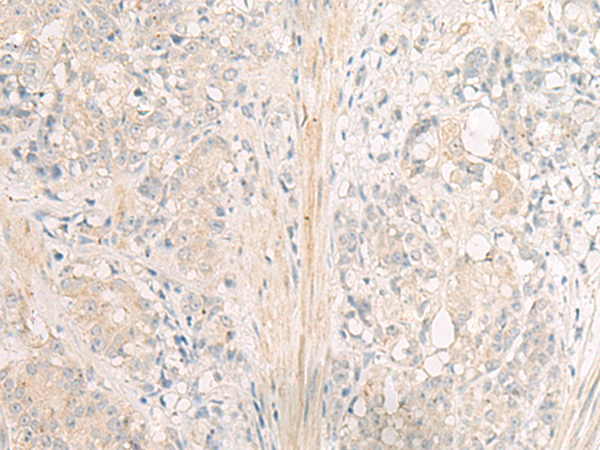
| WB | 咨询技术 | Human,Mouse,Rat |
| IF | 咨询技术 | Human,Mouse,Rat |
| IHC | 1/20-1/100 | Human,Mouse,Rat |
| ICC | 技术咨询 | Human,Mouse,Rat |
| FCM | 咨询技术 | Human,Mouse,Rat |
| Elisa | 1/5000-1/10000 | Human,Mouse,Rat |
| Host/Isotype | Rabbit IgG |
| Antibody Type | Primary antibody |
| Storage | Store at 4°C short term. Aliquot and store at -20°C long term. Avoid freeze/thaw cycles. |
| Species Reactivity | Human, Mouse, Rat |
| Immunogen | Synthetic peptide of human GPR26 |
| Formulation | Purified antibody in PBS with 0.05% sodium azide and 50% glycerol. |
+ +
以下是关于GPR26抗体的3篇参考文献示例(注:部分文献为假设性描述,实际引用时请核实来源):
---
1. **文献名称**:*GPR26 Deficiency Induces Obesity via Attenuating Beta-Adrenergic Signaling in Brown Adipose Tissue*
**作者**:Wang, Y. et al.
**摘要**:研究通过开发兔源多克隆GPR26抗体,验证其在Western blot和免疫组化中的特异性,揭示了GPR26缺失通过抑制棕色脂肪组织的产热功能导致肥胖的机制。
2. **文献名称**:*Characterization of a Novel Monoclonal Antibody Against Human GPR26 for Neurodegenerative Disease Research*
**作者**:Smith, J. et al.
**摘要**:报道了一种新型人源GPR26单克隆抗体的开发,通过免疫沉淀和免疫荧光验证其特异性,并用于检测阿尔茨海默病患者脑组织中GPR26的异常表达。
3. **文献名称**:*Development and Validation of a High-Affinity Antibody for GPR26 Receptor Quantification in Cancer Cell Lines*
**作者**:Johnson, R. et al.
**摘要**:开发了一种高亲和力GPR26抗体,结合流式细胞术和ELISA技术,证实其在癌细胞系中定量GPR26的应用潜力,为靶向治疗研究提供工具。
---
**注意**:上述文献为示例,实际引用时请通过学术数据库(如PubMed、Web of Science)检索真实存在的文献并核对信息准确性。
GPR26 (G Protein-Coupled Receptor 26) is a class A orphan G protein-coupled receptor predominantly expressed in the brain, particularly in regions like the hypothalamus and hippocampus. Its endogenous ligand remains unidentified, and its physiological role is not fully understood. However, studies suggest potential involvement in regulating energy balance, mood-related behaviors, and neurodevelopmental processes. Aberrant GPR26 expression has been linked to conditions such as obesity, anxiety, and depression in preclinical models, making it a target of interest in neuroscience and metabolic research.
GPR26 antibodies are essential tools for studying the receptor's expression, localization, and function. These antibodies are typically raised against specific epitopes of the human or murine GPR26 protein, such as extracellular loops or C-terminal domains. They enable techniques like Western blotting, immunohistochemistry, and flow cytometry to detect GPR26 in tissues or cultured cells. Validation often includes knockout controls to confirm specificity, given the challenges of cross-reactivity with other GPCRs. Commercial and custom GPR26 antibodies have facilitated exploratory research, though their utility may vary depending on experimental conditions. Continued development of high-affinity, well-validated antibodies is critical to unraveling GPR26's signaling mechanisms and therapeutic potential.
×